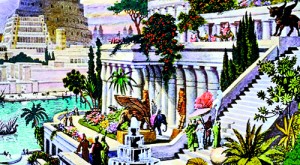Sunday Times 2
Mystery of the missing Hanging Gardens of Babylon solved?
According to ancient texts, the Hanging Gardens of Babylon boasted elaborate terraces, magnificent water features and floating plants.
The decadent grounds are reputed to have been built in the Babylon province of Iraq — yet for centuries no-one has been able to find any physical evidence they existed.
However, according to one expert, closer analysis of these texts — along with clues on display at the British Museum — suggest that this may be because archaeologists have been searching in the wrong place.

As one of the Seven Wonders of the World, the gardens (illustration pictured) were called 'hanging' because they were built high above the ground on split-level stone terraces. Ancient texts referred to the plants in the gardens as 'floating' but they were believed, instead, to have hung from these different terraces
According to Dr. Stephanie Dalley from Oxford University, the gardens are actually buried in the ancient city of Nineveh, near modern-day Mosul, 350 miles away in northern Iraq.
Dr. Dalley from the university’s Oriental Institute has spent the past 20 years researching the location of the gardens, referred to by some as a myth due to the lack of physical evidence.
They were believed to have been built around 600 BC, although this date was taken from ancient texts written hundreds of years after they were said to have been created.
One text specifically claimed the gardens were built by Babylonian Emperor Nebuchadnezzar in the Babylon province of Iraq for his wife Amyitis.
Yet there was no mention of them in any text written by the Emperor or his wife.
This led Dr. Dalley to study these texts more closely and during her research she discovered a prism at the British Museum in London covered in cuneiform writing.
Cuneiform is an ancient language dating back to the Babylonian era, that was also used by the Assyrian empires.
The prism contains details of a king called Sennacherib who was leader of the Assyrian empire and lived a century before Nebuchadnezzar.
The writing included references to a palace built near the Assyrian capital of Nineveh as well as a garden he called ‘wonder for all people.’
Sennacherib’s grandson Assurbanipal was also said to have drawn an image of the garden on a panel in this palace.
During a Channel 4 documentary called Finding Babylon’s Hanging Garden, Dr. Dalley was able to combine ancient maps with modern-

During a Channel 4 documentary called Finding Babylon's Hanging Garden, Dr Stephanie Dalley, pictured right, was able to combine ancient text found on a prism at the British Museum, pictured left, with ancient maps and modern-day versions to locate what she believes to be the ruins of the gardens
day versions to locate what she believes to be the ruins of the palace.
Nearby she found a large mound of dirt sloping to a stretch of greenery which she claims is the ‘best place’ for the ancient site.
She believes her claims are substantiated by a bas-relief, taken from Nineveh, that detailed the location of the palace alongside a garden with trees hanging from terraces.
Furthermore, Dr. Dalley claimed in the documentary that Nineveh was also known as New Babylon and added this may be where the confusion came from.
A Greek historian named Diordorus Siculus described the gardens as being 400ft wide by 400ft long, with walls as high as 80ft.
Due to this height, water was said to have been transported from a lake at the bottom using a similar principle as Archimedes’ screw – a pump that scoops up water in a spiral tube and carries it to the top.
The pump was said to have been invented by Archimedes in the 3rd Century BC yet if a similar system was used in the gardens, this would predate it by around 350 years.
Given the size, historians have estimated the gardens would have used 8,200 gallons of water a day to water the plants.
Some historians and archaeologists believe the gardens were destroyed by war and erosion, while others believe an earthquake destroyed them.
Dr. Dalley believes more research will need to be carried out before archaeologists can confirm the location of the gardens.
She said: ‘More research is now required at the site, but sadly I don’t think that will be possible in my lifetime.
‘My conviction that the gardens were in Ninevah remains unshaken.’
© Daily Mail, London


